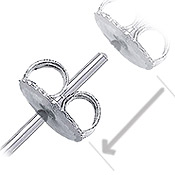Your Online Source for Wholesale Diamonds


Natural Fancy Yellow Color Diamond
Diagram of Fancy Colored Diamonds(Canary)
Range from Vivid to Light
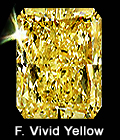
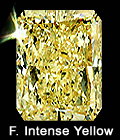
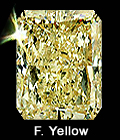
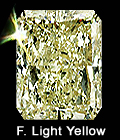
Diagram of Non-fancy Diamond
Range from Z - U
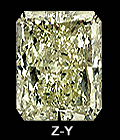
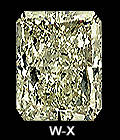
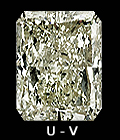
Most diamonds used as gemstones are basically transparent with little tint, or white diamonds. The most common impurity, nitrogen, replaces a small proportion of carbon atoms in a diamond's structure and causes a yellowish to brownish tint.
Beautiful yellow diamonds exist in tones from light yellow to fancy intense vivid yellow, also named Canary Yellow, depending on the concentration of nitrogen when the crystal is formed. Yellow diamonds are more desirable than white diamonds, due to their warm color. In fancy diamonds, inclusions are mostly not noticeable to the naked eye because of its rich color, inclusions does not affect the look or its sparkles not like in clear diamonds.
Natural fancy coloured diamonds are very rare and expensive. Most people believe that yellow diamonds are less desirable and valuable than white diamonds. While this is true of faintly coloured or off-white diamonds, intensely coloured diamonds are very attractive, rare and expensive. The Kimberley Octahedron is the largest diamond in the world at about 616 carats, and is yellow.
Grading fancy color diamonds
Yellow or brown color diamonds having color more intense than "Z", as well as diamonds exhibiting color other than yellow or brown are considered fancy colored diamonds. These diamonds are graded using separate systems which indicate the characteristics of the color, and not just its presence. These color grading systems are similar to those used for other colored gemstones, such as ruby, sapphire, or emerald, than they are to the system used for white diamonds.
GIA colored diamond grading system
The GIA issues grading a Colored Diamond Grading Report for colors that are not in the normal color range of diamonds. Formal GIA terms used to describe natural yellow diamonds:
|
Gran Colorimeter |
|
Color can also be determined using a device called the Gran Colorimeter, manufactured by Sarin Technologies. It measures from D to Z to Fancy Intense with an accuracy within ±½ of a color grade on loose stones from 0.25 to 10 carats (as low as .15 carat or as high as 20 carats with reduced accuracy), and you can specify which grading scale it should use (GIA, GEM, IGI, AGS, HRD, and others). The accuracy is within ±1 color grade for mounted stones. If you diamond is a "G" color it will tell you whether it's a "high G" or a "low G." The Gran colorimeter was first developed by Paul Gran in 1972 at Gran Computer Industries Ltd. |
Natural Fancy Yellow Color Diamond
Diagram of Fancy Colored Diamonds(Canary)
Range from Vivid to Light




Diagram of Non-fancy Diamond
Range from Z - U



Most diamonds used as gemstones are basically transparent with little tint, or white diamonds. The most common impurity, nitrogen, replaces a small proportion of carbon atoms in a diamond's structure and causes a yellowish to brownish tint.
Beautiful yellow diamonds exist in tones from light yellow to fancy intense vivid yellow, also named Canary Yellow, depending on the concentration of nitrogen when the crystal is formed. Yellow diamonds are more desirable than white diamonds, due to their warm color. In fancy diamonds, inclusions are mostly not noticeable to the naked eye because of its rich color, inclusions does not affect the look or its sparkles not like in clear diamonds.
Natural fancy coloured diamonds are very rare and expensive. Most people believe that yellow diamonds are less desirable and valuable than white diamonds. While this is true of faintly coloured or off-white diamonds, intensely coloured diamonds are very attractive, rare and expensive. The Kimberley Octahedron is the largest diamond in the world at about 616 carats, and is yellow.
Grading fancy color diamonds
Yellow or brown color diamonds having color more intense than "Z", as well as diamonds exhibiting color other than yellow or brown are considered fancy colored diamonds. These diamonds are graded using separate systems which indicate the characteristics of the color, and not just its presence. These color grading systems are similar to those used for other colored gemstones, such as ruby, sapphire, or emerald, than they are to the system used for white diamonds.
GIA colored diamond grading system
The GIA issues grading a Colored Diamond Grading Report for colors that are not in the normal color range of diamonds. Formal GIA terms used to describe natural yellow diamonds:
|
Gran Colorimeter |
|
Color can also be determined using a device called the Gran Colorimeter, manufactured by Sarin Technologies. It measures from D to Z to Fancy Intense with an accuracy within ±½ of a color grade on loose stones from 0.25 to 10 carats (as low as .15 carat or as high as 20 carats with reduced accuracy), and you can specify which grading scale it should use (GIA, GEM, IGI, AGS, HRD, and others). The accuracy is within ±1 color grade for mounted stones. If you diamond is a "G" color it will tell you whether it's a "high G" or a "low G." The Gran colorimeter was first developed by Paul Gran in 1972 at Gran Computer Industries Ltd. |
